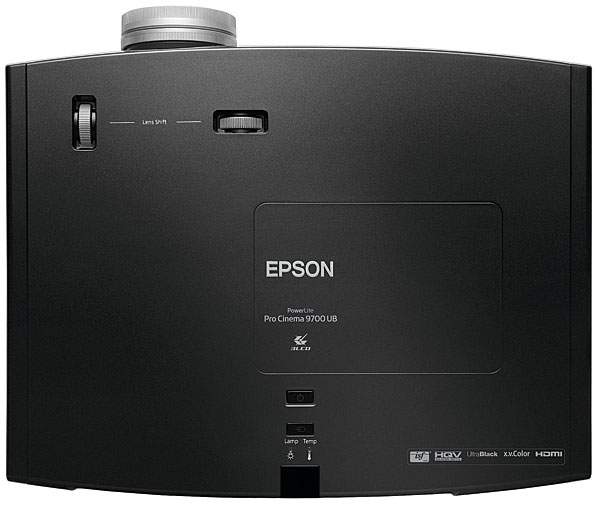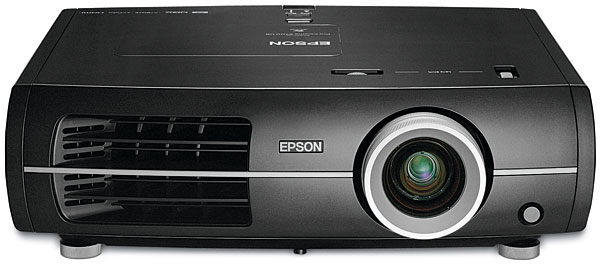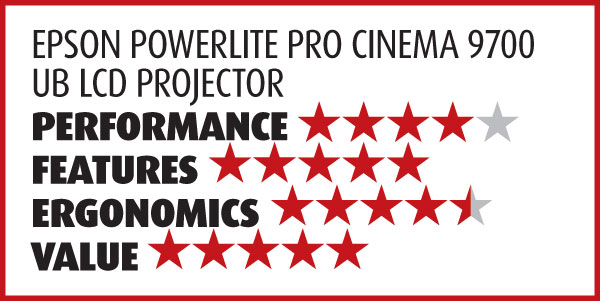The 9700 UB does in fact come with a ceiling mount.
Epson PowerLite Pro Cinema 9700 UB LCD Projector Page 2
In Use
Out of the box, the 9700 UB’s performance was far better than its price tag suggests. This is the kind of projector that would more than just satisfy the bulk of the population; it would blow them away. Convergence wasn’t an issue, and my review unit showed less than a half pixel of misalignment across the screen. From my seating position, I couldn’t even detect it. Uniformity was also outstanding, with no obvious hot spots.
I quickly dialed in the Epson using the THX preset, then calibrated the projector with the user menus. Gray scale was a tad warm, but it dialed in nicely using the RGB controls. The color management system also worked quite well and let me set the unit up nearly perfectly for all aspects of the color gamut including luminance.

After I had everything ready, I wanted to test the video processing suite. Since the HQV badge was on full display on the chassis, I expected it to do just fine—and sure enough, it did. The projector had no issues with our deinterlacing tests for both standard-definition and highdefinition sources. However, to pass the 2:2 tests for both high and standard definition, I had to switch the deinterlacing setting to Film. While this is typical for most video processors, it resulted in a Fail in our testing. We demand that a unit pass in its default deinterlacing mode. I saw some minor noise in our motion adaptive test compared with other displays I’ve tested, but it still passed the core parts of the test. If you aren’t sure about your Blu-ray player’s video processing, I suggest that you feed the projector an interlaced signal and let the Epson perform the deinterlacing and scaling with DVDs. You’d be hard-pressed to find a Blu-ray or DVD player that would outperform it in this area.
One of my other nitpicks was chroma resolution. When I used a luma and chroma burst to check the projector’s overall resolution, I found that the high-frequency horizontal chroma resolution was almost completely rolled off. None of the video enhancement settings had any effect on this. This wasn’t something Tom Norton noticed in his review of the 9500 UB; it seems to be new to this model. The 9700 UB wasn’t as tack sharp as some of the higher-end projectors I typically deal with. I’m sure this didn’t help, but it also didn’t take away from my experience viewing the colorful animation I watched during the review, including the Blu-ray releases of How to Train Your Dragon and Toy Story 3.
Next up were some tests of the dynamic iris system, which Epson dubs UltraBlack. While these systems always result in higher contrast (and this one was no exception), there’s a price to pay. Image pumping is usually the biggest result. Depending on how aggressive the iris is and how fast it operates, you’ll see obvious changes in the overall image brightness as the average picture level changes (pumping). Sometimes, you’ll also see some brightness compression artifacts, resulting in clipped or crushed white details. While I didn’t see any brightness compression artifacts, I saw some obvious pumping. The Normal UltraBlack setting was the least distracting. It caused only some minor issues with very difficult material. The Fast mode was a bit too aggressive. Depending on the demo material I used, the transitions were so abrupt that it called attention to itself. With UltraBlack off, there was an obvious rise in black levels, so you have to pick your poison. For most of my viewing, I left UltraBlack on Normal, which seemed to be the best compromise for most program material.

After all my serious testing was done, I spent several weeks using the projector for daily viewing and more testing with familiar material. My overall impression was wow. Projection technology has gotten much better over the last five years. What you can buy for less than $5,000 now is leaps and bounds better than the projectors that cost north of $10,000 just a few years ago. The Epson has a solid image, plenty of depth, and resolution that came up just slightly short of the high-end projectors I’m used to viewing
in my theater. The 9700 UB is slightly softer than my reference JVC DLA-RS35, but that projector retails for nearly four times as much. The Epson also couldn’t compare to my reference JVC in overall contrast performance. However, the dynamic iris did a respectable job even with the darkest material I threw at it.
Wrap It Up
The Epson PowerLite Pro Cinema 9700 UB is a projector that was designed for the masses. If you’re a video zealot like me, you’ll find a few things to nitpick, but that’ll be the case with any projector at any price. The Epson delivers spectacular features and performance for an unbelievable price. Its predecessor was a Top Pick for the same reasons, and this model continues to serve as one of the best values on the projector market today. If you want a true cinema experience at home but don’t want to pay a fortune for it, look no further.

- Log in or register to post comments





































































